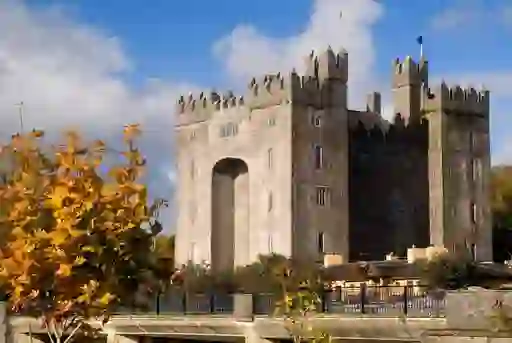

King John’s Castle
King John’s Castle has dominated Limerick city’s skyline for eight centuries.
The castle’s vast interior sheds new light on its evolution since it was built by King John – the notorious villain from Robin Hood lore – on the site of a sturdy Viking settlement. These days, costumed guides, interactive wizardry from touch-screen technology and ghostly 3D visitors are all to hand to immerse visitors in medieval battles, losses and triumphs.
Outside, the courtyard offers an open space for people of all ages to test their feudal skills with archery, horseshoe throwing or tug of war in a busy, old-world setting. However, to get a real flavour of Limerick city and the castle’s dramatic setting – climb to the top of its ancient towers and peer over the battlements for panoramic views. Below, the Shannon – the longest river in both Britain and Ireland – gushes by at full tide on its way to the Atlantic Ocean.
Limerick city’s Medieval Quarter
L-R: King John’s Castle; the Treaty Stone; St Mary’s Cathedral; stone carvings on St Mary’s Cathedral
From your perch on the castle battlements, cast an eye across the river to discover the Treaty Stone – a large plinth by an embankment pathway that played an important role in Ireland’s bitter 17th century wars. The stone had a powerful impact on Irish history and gave Limerick its nickname – the Treaty City.
Next, trace the city’s roofscape – from the fortress’s turrets to the slated gables and timber roof trusses of the Medieval Quarter, or follow the river west to see its elegant bridges, best viewed in the early evening glow when lamplight is reflected onto the rippling water. This section of the river creates the contour of Georgian Limerick and the modern-day city.


Thomond Bridge and King John’s Castle, Limerick city
Before ambling too far from the castle, there’s still plenty of ground to cover in the medieval heart of the city. Thomond Bridge – built to service the castle – links two of the city’s oldest pubs, Katie Daly’s and JJ Bowles, from opposite sides of the Shannon. For a flavour of something new, The Treaty Brewery on Nicholas Street gives visitors the chance to sample the city’s very own craft beer.
Step back into the past at the 12th century Gothic and Romanesque St Mary’s Cathedral. The cathedral was built by King Donal Mór O’Brien, a direct descendant of Ireland’s only high king, Brian Boru. It’s teeming with idiosyncratic features such as the leper’s squint in the north wall, tucked in by the organ pipes. It served as a slot to the street where the sick and diseased received sacraments. Other oddities include the cannon balls from the infamous 1691 siege that hang in the archway and a Romanesque-style door with stone monster heads.


Bunratty Castle, County Clare
Neighbouring villages bring their own charm – and are accessible by a short bus or car ride from the city. Adare is oozing with pastoral beauty thanks to a main street lined with thatched roofed cottages and vernacular homes. Adare Manor, a super-deluxe historic hotel, teeming with elegant trappings and a landmark golf club is the star attraction here.
To the west of Limerick in County Clare is Bunratty Village – another picture-perfect hamlet that punches above its weight in visitor appeal. Bunratty Castle and Folk Park offers hours of recreational fun, including a replica 19th century street and medieval feasts in the castle. Then it’s time to retreat with the forces back to Limerick city to indulge in its fine restaurants and vibrant nightlife.


Micheal Hogan statue at King John's Castle plaza, County Limerick
Need to know: King John’s Castle
You should plan between one and two hours for a visit to King John’s Castle.
The castle is open seven days a week, all year round, from 9:30am until 5pm. The last admission is at 4pm.
It’s recommended that you book tickets online to avoid disappointment. Walk-ins are admitted if capacity allows.
Discount tickets are available for children, students and seniors.
All pay points in the castle accept contactless payment.
While the exhibition areas and towers are fully covered, the courtyard is not so remember to bring your rain gear!
You can refuel in the onsite café which boasts views of the courtyard and the river and then enjoy a browse in the craft and gift shop.
Parking in the King John’s Castle car park (across the road from the castle) is included in your ticket price.
The exhibition and the courtyard are accessible by wheelchair but the undercroft and castle towers are not.
















































